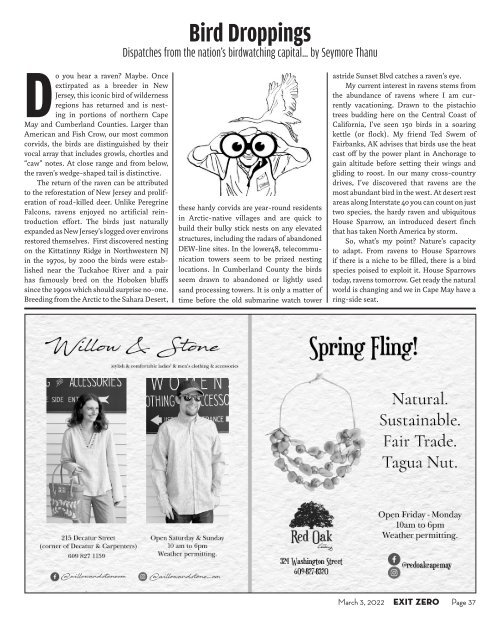V20 N4
March 3, 2022 V20 N4
March 3, 2022
V20 N4
Create successful ePaper yourself
Turn your PDF publications into a flip-book with our unique Google optimized e-Paper software.
Bird Droppings<br />
Dispatches from the nation’s birdwatching capital… by Seymore Thanu<br />
Do you hear a raven? Maybe. Once<br />
extirpated as a breeder in New<br />
Jersey, this iconic bird of wilderness<br />
regions has returned and is nesting<br />
in portions of northern Cape<br />
May and Cumberland Counties. Larger than<br />
American and Fish Crow, our most common<br />
corvids, the birds are distinguished by their<br />
vocal array that includes growls, chortles and<br />
“caw” notes. At close range and from below,<br />
the raven’s wedge-shaped tail is distinctive.<br />
The return of the raven can be attributed<br />
to the reforestation of New Jersey and proliferation<br />
of road-killed deer. Unlike Peregrine<br />
Falcons, ravens enjoyed no artificial reintroduction<br />
effort. The birds just naturally<br />
expanded as New Jersey’s logged over environs<br />
restored themselves. First discovered nesting<br />
on the Kittatinny Ridge in Northwestern NJ<br />
in the 1970s, by 2000 the birds were established<br />
near the Tuckahoe River and a pair<br />
has famously bred on the Hoboken bluffs<br />
since the 1990s which should surprise no-one.<br />
Breeding from the Arctic to the Sahara Desert,<br />
these hardy corvids are year-round residents<br />
in Arctic-native villages and are quick to<br />
build their bulky stick nests on any elevated<br />
structures, including the radars of abandoned<br />
DEW-line sites. In the lower48, telecommunication<br />
towers seem to be prized nesting<br />
locations. In Cumberland County the birds<br />
seem drawn to abandoned or lightly used<br />
sand processing towers. It is only a matter of<br />
time before the old submarine watch tower<br />
astride Sunset Blvd catches a raven’s eye.<br />
My current interest in ravens stems from<br />
the abundance of ravens where I am currently<br />
vacationing. Drawn to the pistachio<br />
trees budding here on the Central Coast of<br />
California, I’ve seen 150 birds in a soaring<br />
kettle (or flock). My friend Ted Swem of<br />
Fairbanks, AK advises that birds use the heat<br />
cast off by the power plant in Anchorage to<br />
gain altitude before setting their wings and<br />
gliding to roost. In our many cross-country<br />
drives, I’ve discovered that ravens are the<br />
most abundant bird in the west. At desert rest<br />
areas along Interstate 40 you can count on just<br />
two species, the hardy raven and ubiquitous<br />
House Sparrow, an introduced desert finch<br />
that has taken North America by storm.<br />
So, what’s my point? Nature’s capacity<br />
to adapt. From ravens to House Sparrows<br />
if there is a niche to be filled, there is a bird<br />
species poised to exploit it. House Sparrows<br />
today, ravens tomorrow. Get ready the natural<br />
world is changing and we in Cape May have a<br />
ring-side seat.<br />
March 3, 2022 EXIT ZERO Page 37


















